Family : Coryphaenidae

Text © Giuseppe Mazza

English translation by Mario Beltramini
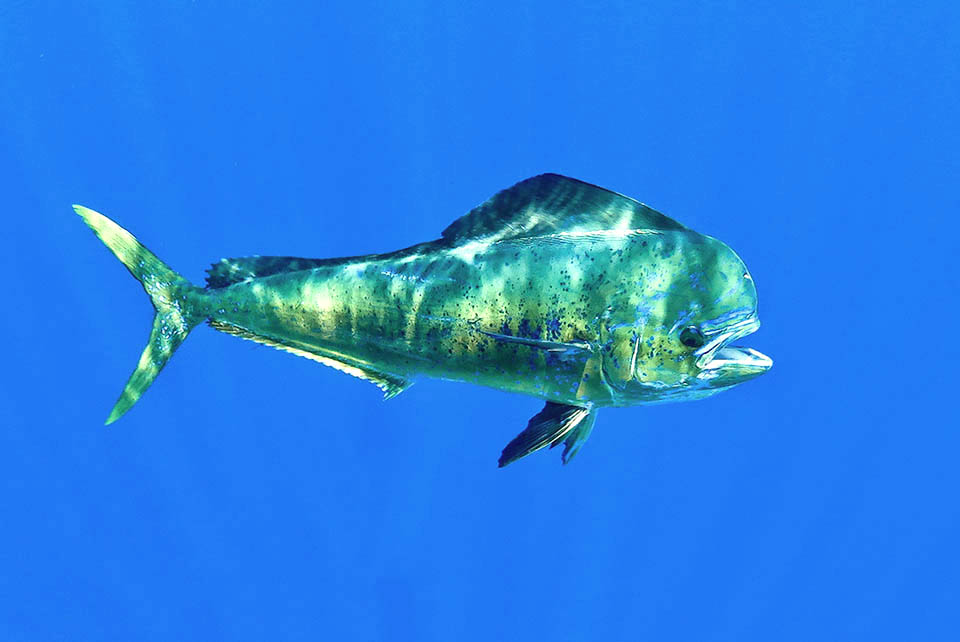
The Common dolphinfish, Coryphaena hippurus, is a fish that may exceed 2 m present in tropical and subtropical waters all over the world © Le Gallais
The Common dolphinfish, Coryphaena hippurus Linnaeus,1758, belongs to the class of the Actinopterygii, the ray-finned fishes, and to the order of the Carangiformes that, after the Eschmeyer’s Catalog of Fishes, includes the vast family of the Carangidae, with almost 150 species, and other 6 small families: Echeneidae grouping the remorae, Istiophoridae with 11 marlins, Nematistiidae with the unusual Nematistius pectoralis characterized by 7 very long dorsal spines, Rachycentridae with Rachycentron canadum with its elongated body and depressed head, Xiphiidae with Xiphias gladius, another swordfish with different characteristics, and finally Coryphaenidae with Coryphaena hippurus and the smaller Coryphaena equiselis.
The genus Coryphaena originates from the Greek “korus”, helmet, and “phaino”, to manifest, to show, due to the bony protuberance on the head of the male.
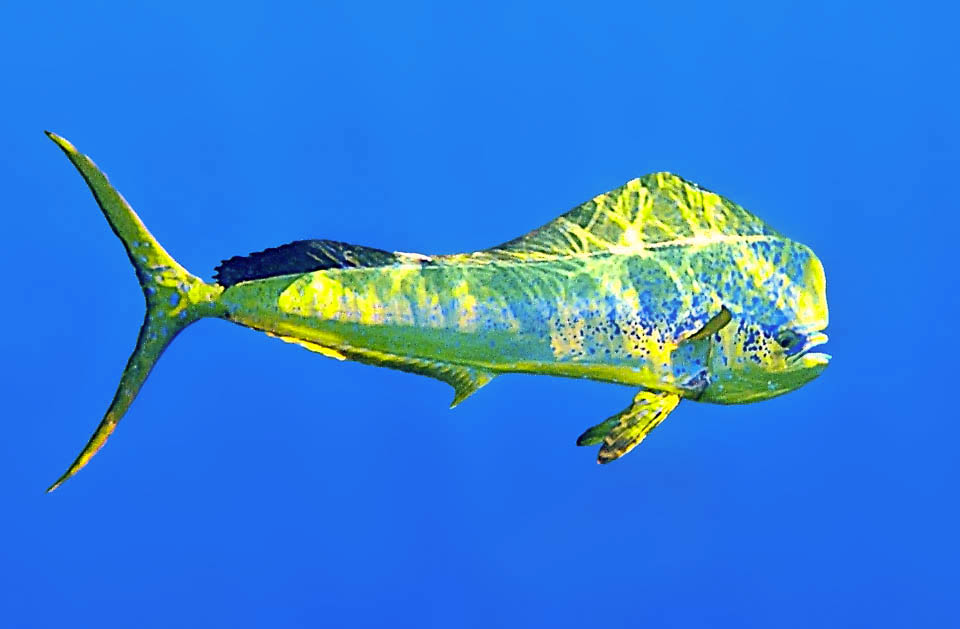
Is also called Chameleon fish, for its speed in changing colour with splendid liveries. Here a male with the characteristic squared head © Rafael
The specific term hippurus, from “ippos”, horse and “ouros”, tail, adds that the dorsal fin, high in the first part and then degrading to the tail, recalls the mane of a horse.
Zoogeography
Highly migratory species, Coryphaena hippurus is present in the tropical and subtropical waters of the Atlantic, Indian and Pacific oceans.
It is also found in the Mediterranean and even in the north of Ireland, but is more frequent where the temperatures stand between 21 ans 30 °C.
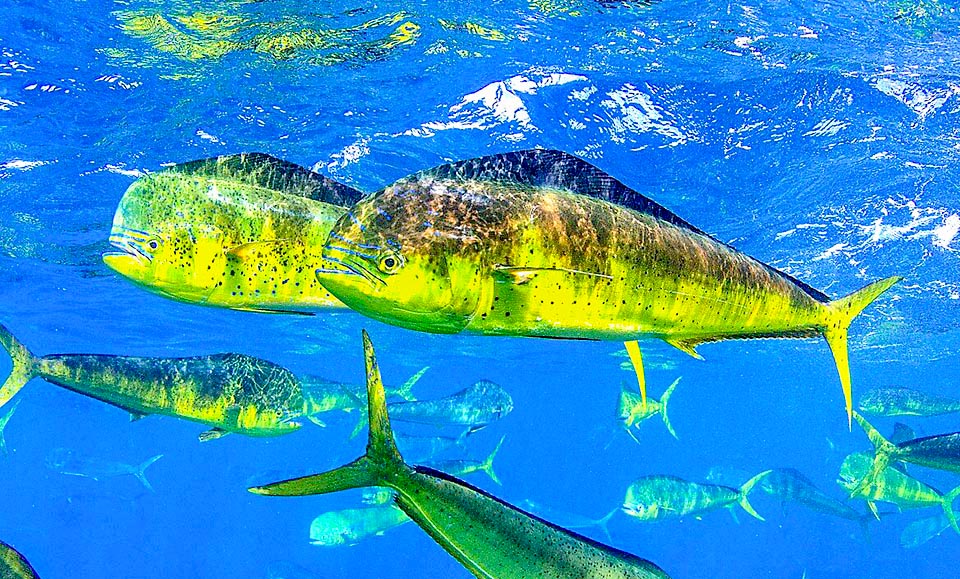
A couple with other colour variations. The foreground female distinguishes for the roundish head profile © Luis Pérez Berrocal
Ecology-Habitat
Coryphaena hippurus is a pelagic-neritic fish, present in coastal and oceanic waters between 0 and 85 m of depth. Usually it goes swimming between 5 and 10 m, even if it has been exceptionally sighted at 255 m and it is not rare to find it on the surface, hence its English name of “Common Dolphinfish”.
Morphophysiology
The Common dolphinfish reaches 210 cm and 40 kg, but the current length is about 1 m.
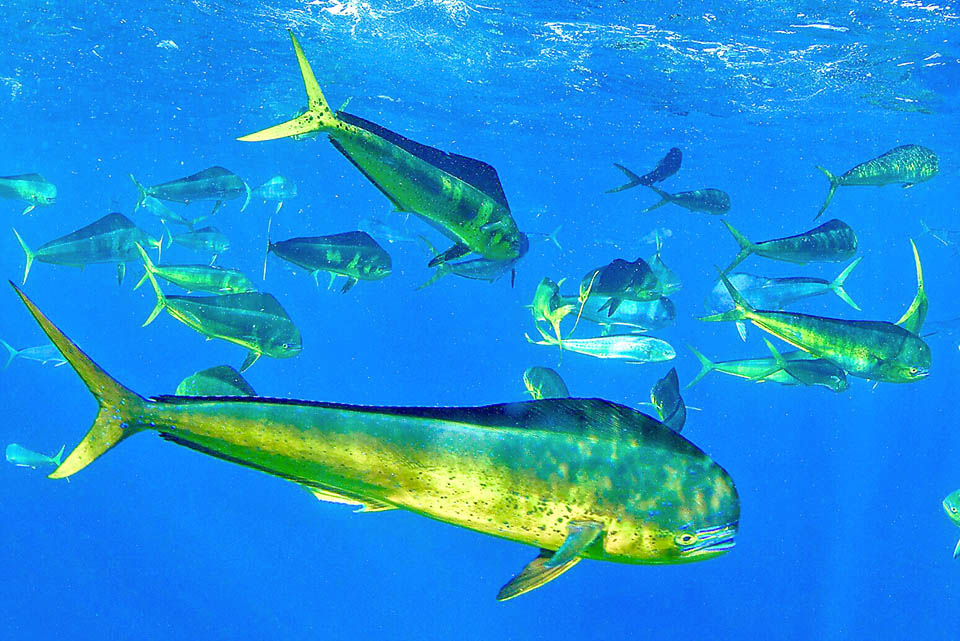
Coryphaena hippurus is an active predator that often feeds on schooling mackerels or other fishes in school, and opportunistically on all those coming into range © Luis Pérez Berrocal
The body is long, slender and streamlined for a fast swimming with peaks of more than 90 km/h, and in order to furnish the oxygen necessary to the muscles, the gills have a surface ampler than most bony fishes.
The fins don’t have spiny rays. The dorsal, with 58-66 rays, starts high on the head and reaches, lowering, the caudal peduncle. The anal, symmetrical with concave front edge, has 25-31 rays.
The pectoral ones, sickle-shaped, are longer than half of the head. The pelvic have a ventral housing where to enter during the fast movements, and the big caudal fin, with equal lobes, narrow and sharp, is deeply forked as befits fast fishes.
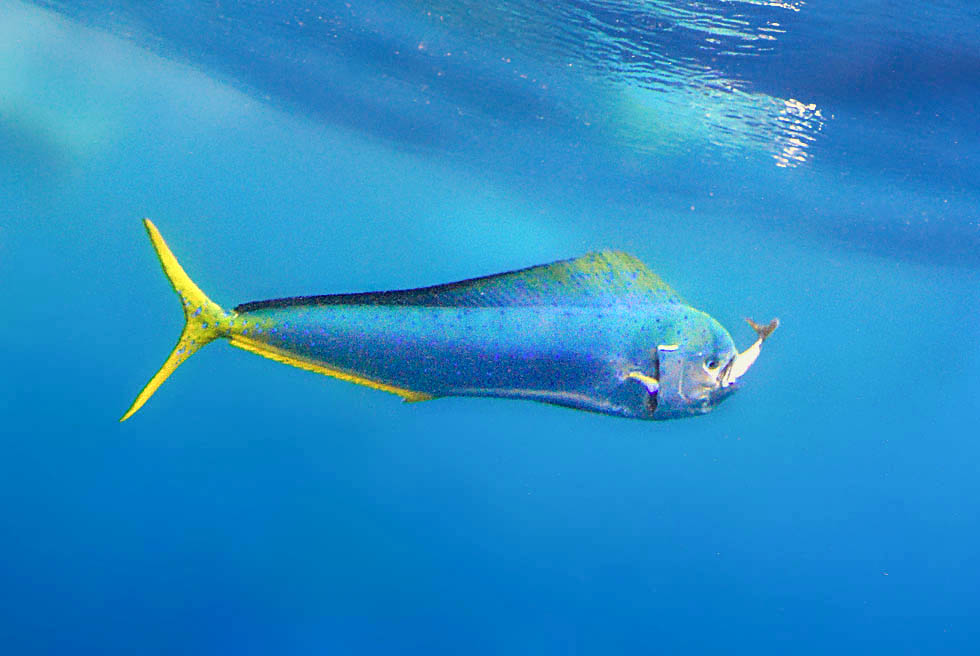
This just grabbed one, but the Common dolphinfish eats also zooplankton, small crustaceans and squids © Luis Pérez Berrocal
The wide mouth has jaws armed with an external row of backward-pointing hooked teeth for holding the preys, followed by dense bands of small teeth, present also on the vomer, the palatines and the tongue where they form a characteristic oval spot.
The tiny scales, embedded in the skin, are almost invisible and smooth to offer no resistance to the water, and hard and spiny shields are not visible on the lateral line that crosses the body horizontally with an unusual inverted U-shaped hump over the pectorals
The livery is showy and changeable; so much that Coryphaena hippurus is also called Chameleon fish. The back and the upper part of the body is usually of metallic blue-green colour, but in a moment, due to the effect of the chromatophores, may turn brown or pearly grey, whilst the sides tend to the shining golden yellow colour with blue dottings and turquoise areas. Splendid colours that, however, disappear rapidly with the animal’s death.
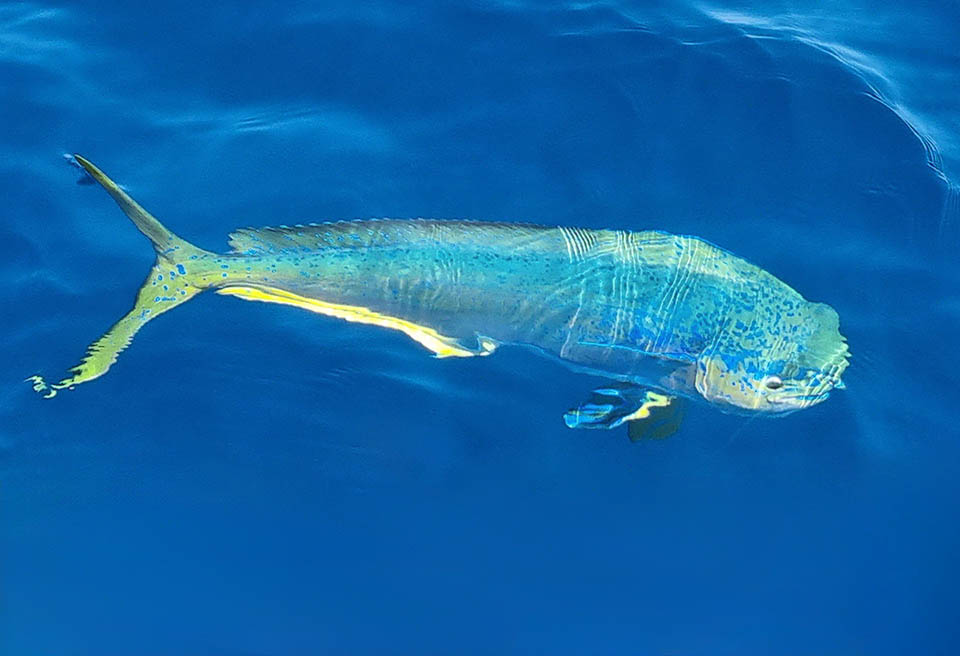
It can track them up to 85 m deep, but swims also quite often in surface hence the English name of Common dolphinfish © Rafael
Also the fins change colour, completely or partially, with the dorsal fading from yellow to black towards the tail, ready to reverse the colours or to go all black, and the anal, usually yellow, with a similar behaviour. The caudal fin is yellow with silver reflections.
The juveniles have about 12 vertical dark bars on the sides, their caudal has white tips and the pelvic are black.
Coryphaena hippurus is characterized by a strong sexual dimorphism. As a matter of fact, the males present a showy bony protuberance on the front going down vertically to the mouth giving the head a square profil, whilst in the females, smaller and thin, this is roundish.
Ethology-Reproductive Biology
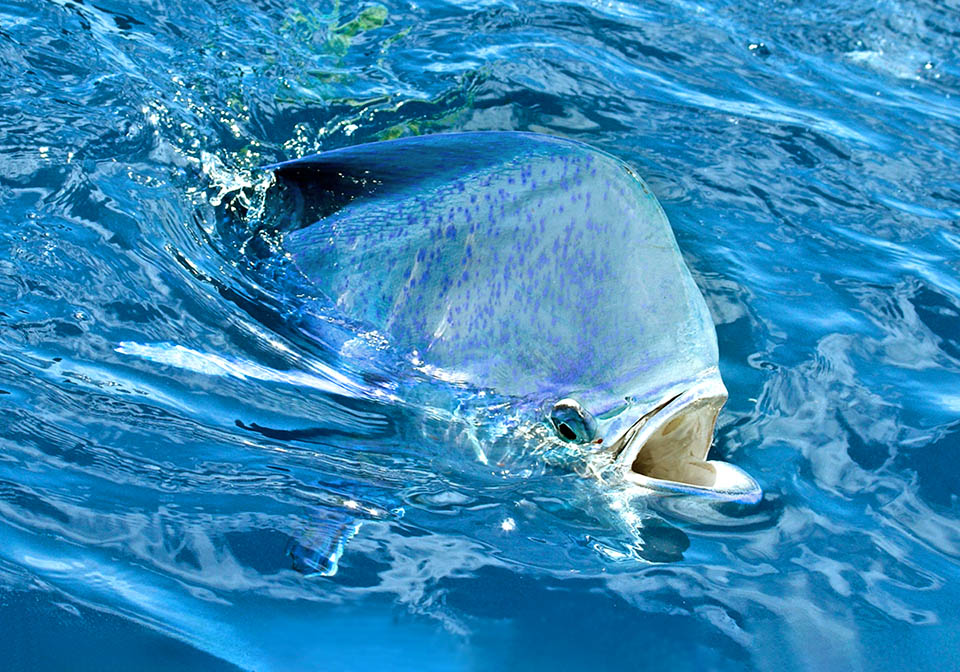
Emerging male perhaps surveying the flying fishes. The jaws are armed with hooked teeth turned backwards, and others smaller, gathered, present even on the tongue © Kye Turnbull
Coryphaena hippurus is an active predator feeding on zooplankton, schooling fishes such as the mackerels, and in an opportunistic way on all those coming within range. It doesn’t leave out the squids and keeps an eye on the flying fishes it seizes skillfully when landing.
The sexual maturity is reached by the first year, usually, depending on the locations, around the 4-5 months when it is 50-60 cm long, and the lifespan is 4-5 years maximum.
The reproduction takes place almost all year round, when the temperature of the water exceeds at least 21 °C, and the spawning happens on several occasions with females that in one season, depending on the size, may entrust to the currents even one million eggs.
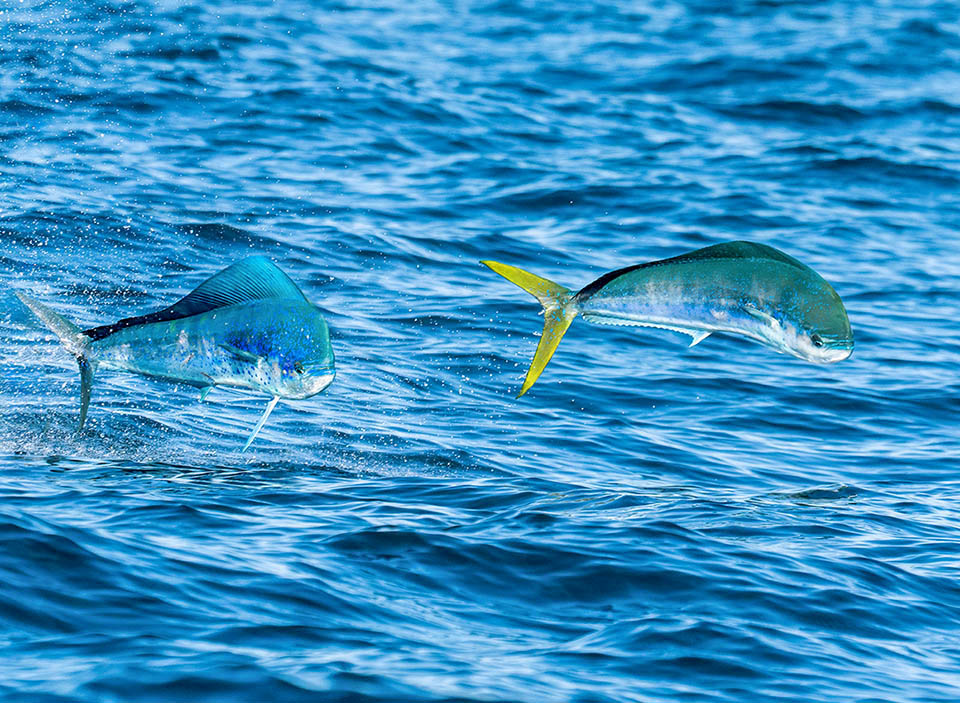
This chases a female with spectacular leaps. Coryphaena hippurus practically reproduces all over the year, when the temperature of the water exceeds 21 °C © Patrick Vant
The larvae, pelagic, can be found up to 180 m in depth.
The resilience of the species is high, with a minimum time for doubling the populations less than 15 months, and the fishing vulnerability, moderate, marks 41 on a scale of 100, although it is a widely caught fish with longlines, by trolling and driftnets. To attract them, before dropping the nets, the fishermen often throw into the sea cork planks or bundles of bamboo canes, because it is under the floating objects, as in nature the drifting sargassoes, that often their preys gather so that they are not seen by the sea birds.
Coryphaena hippurus is finally a fighting fish, very rewarding in big game fishing also because its flesh is excellent, albeit at risk of ciguatera, a serious food poisoning caused in certain locations by the diet of these fishes.
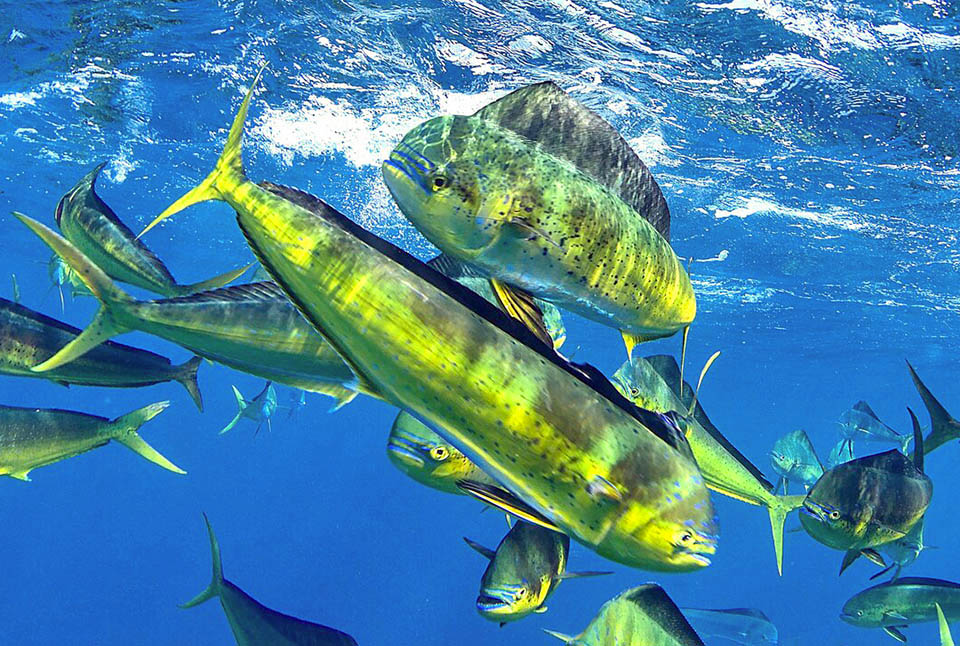
Depending on the size, females may spawn even one million eggs per season. The pelagic larvae can dive down up to 180 m deep.
From 1961 to 2006 the world’s catch reported by FAO for the Common dolphinfish has gradually increased from 17.000 tons to 59.000 tons in 2005. For the Mediterranean, where the Common dolphinfish is expanding and frequent along the Spanish and the Tunisian coats, they talk of 8.000-10.000 tons per year.
Coryphaena hippurus grows rapidly also in pisciculture, with low mortality, and this has led to the creation of hatcheries and farms in various parts of the world.
Concluding, it is not an endangered species and in the 2024 IUCN Red List in fact appears as “Least Concern”.
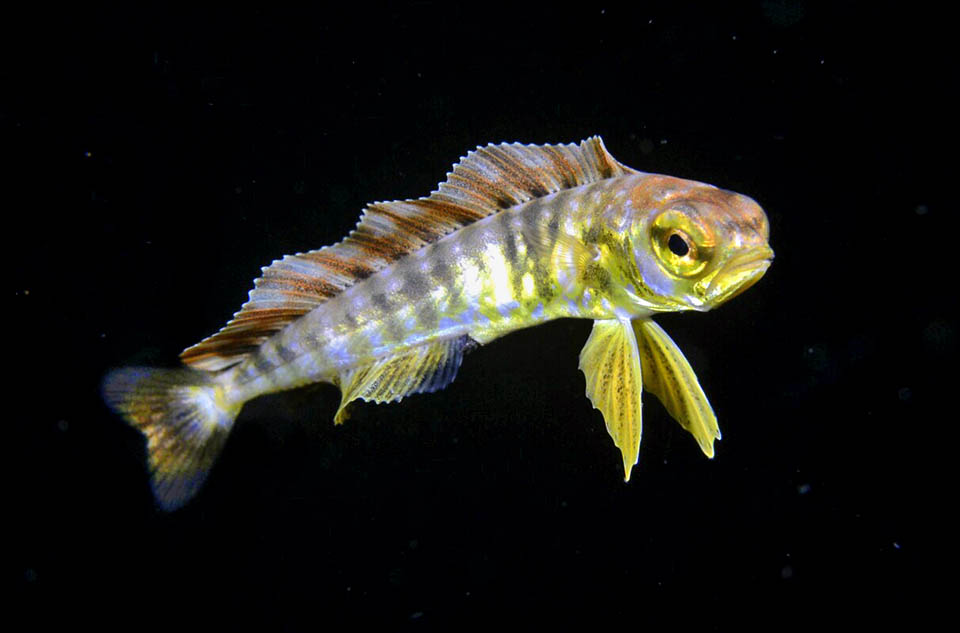
A metamorphosed young. We already see the 12 miletic vertical bars typical of juveniles. Growth is fast, and for the excellent flesh is now bred in pisciculture © Remy Dubas
Synonyms
Coryphaena fasciolata Pallas, 1770; Coryphaena chrysurus Lacepède, 1801; Coryphaena imperialis Rafinesque, 1810; Lepimphis hippuroides Rafinesque, 1810; Coryphaena immaculata Agassiz, 1831; Lampugus siculus Valenciennes, 1833; Coryphaena scomberoides Valenciennes, 1833; Coryphaena margravii Valenciennes, 1833; Coryphaena margravii Valenciennes, 1833; Coryphaena dorado Valenciennes, 1833; Coryphaena dolfyn Valenciennes, 1833; Coryphaena virgata Valenciennes, 1833; Coryphaena argyrurus Valenciennes, 1833; Coryphaena vlamingii Valenciennes, 1833; Coryphaena nortoniana Lowe, 1839.
